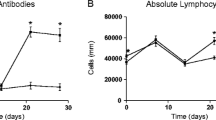Summary
The normal histologioal features of the lymphatic organs — pericardial nodes, jugular bodies, spleen, and kidney — of the marine toad, Bufo marinus, are decribed. The lymph nodes and spleen of the marine toad lack the compartmental organization of corresponding mammalian organs and contain relatively less internal connective tissue. The cellular stroma composed of reticulum cells and fixed macrophages plays a more important role in maintaining structural organization than do the connective tissue.
Changes in the cellular composition of the lymphatic parenchyma were observed in animals immunized with bovine serum albumin suspended in Freund's complete adjuvant. In addition to an increase in the number of lymphocytes and the presence of lymphoid hemocytoblasts, cells occurred which possessed many of the morphological characteristics of mammalian plasma cells. These plasma cells, which exhibited positive fluorescent antibody reaction, were more abundant in the kidney than in the lymph nodes or spleen of an immunized animal.
Granulomas developed at the site (gastrocnemius muscle) of injection of antigen in complete adjuvant, and similar cystic lesions arose in the kidney. Apparently, the antigen-adjuvant mixture found its way from the site of injection (gastrocnemius muscle) into the kidney, probably via the renal portal system, and established lesions in the kidney. Appreciable numbers of antibody-forming cells, or plasma cells, were found in the muscle granulomas and in the kidney lesions.
The lymphoid tissue of the kidney is considered the principal site of antibody formation in the marine toad, Bufo marinus.
Similar content being viewed by others
References
Braumühl, A. v.: Über einige myelo-lymphoide und lympho-epitheliale Organe der Anuren. Z. mikr.-anat. Forsch. 4, 635–688 (1926).
Clem, L. W., and P. A. Small: Phylogeny of immunoglobulin structure and function. I. Immunoglobulins of the lemon shark. J. exp. Med. 125, 893–920 (1967).
Diener, E., and G. J. V. Nossal: Phylogenetic studies on the immune response. I. Localization of antigens and immune response in the toad, Bufo marinus. Immunology 10, 535–542 (1966).
Evans, E. E., S. P. Kent, R. E. Bryant, and M. Moyer: Antibody formation and immunological memory in the marine toad. In: Phylogeny of Immunity (R. T. Smith, P. A. Meichsner and R. A. Good, (eds.), p. 218–226. Gainesville: University of Florida Press 1966.
Good, R. A., and B. W. Papermaster: Ontogeny and phylogeny of adaptive immunity. In: Advances in Immunology (F. J. Dixon and J. H. Humphrey, (eds.), vol. 4, p. 1–115. New York: Academic Press 1964.
Kent, S. P., E. E. Evans, and M. H. A. Attleberger: Comparative immunology. Lymph nodes in the amphibian, Bufo marinus. Proc. Soc. exp. Biol. (N.Y.) 116, 456–459 (1964).
Marchalonis, J., and G. M. Edelman: Phylogenetic origins of antibody structure. II. Immunoglobulins in the primary immune response of the bullfrog, Rana catesbiana. J. exp. Med. 124, 905–913 (1966).
Smith, R. T., P. A. Meichsner, and R. A. Good: Phylogeny of Immunity. Gainesville: University of Florida Press 1966.
Ward, J. W., and G. H. Ezell: Further blood studies in marine fish. Anat. Rec. 157, 337–338 (1967).
Zaborsky, F., u. F. Huth: Vergleichende licht- und elektronenmikroskopische Untersuchungen zur Morphologie und Funktion des Corpus jugulare von Anuren. Z. Zellforsch. 65, 253–271 (1965).
Author information
Authors and Affiliations
Additional information
This investigation was supported by grants HD-2614-1 and GM-11782 from the United States Public Health Service administered by Dr. Ronald R. Cowden and Dr. E. Peter Volpe, respectively.
Rights and permissions
About this article
Cite this article
Cowden, R.R., Gebhardt, B.M. & Volpe, E.P. The histophysiology of antibody-forming sites in the marine toad. Z. Zellforsch. 85, 196–205 (1968). https://doi.org/10.1007/BF00325034
Received:
Issue Date:
DOI: https://doi.org/10.1007/BF00325034




